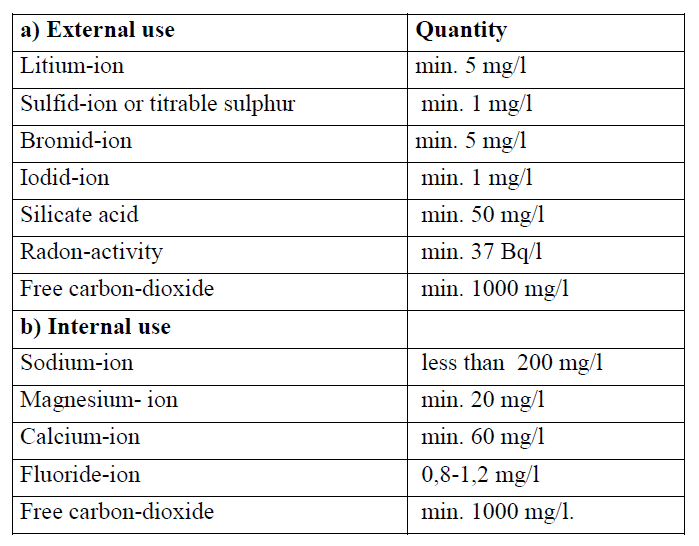Mineral waters
Those underground waters can be called mineral waters which do not contain harmful substances and their mineral content is a minimum of 1 g/1,000mg.
Acknowledged by Hungarian regulations mineral waters
a) derive from naturally or artificially protected underground water sources
b) at their place of origin they are pure, free of anthropogenic pollution
c) In their natural form they are harmless for humans from microbiological and chemical point of view.,
d) their composition and dissolved mineral content when measured at the source is nearly constant.
e) their dissolved mineral content is at least 1,000 mg/l, or their dissolved solid mineral content is between 500-1000 mg/l and they contain one of the following biologically active substances. (Table 1):
Table 1. The lowest end value of biologically active substances in acknowledged mineral waters. Source: Amendment No2. to decree 74/1999. (XII. 25.) EüM (net.jogtar.hu)

The above criteria meet the requirements of external use. If mineral waters are used internally, they may be consumed without any restriction if their mineral content is optimal or near optimal for humans, that is, they are suitable to meet fully or partially our biological needs for water. They can be consumed with some restrictions if their mineral or biologically active substances content in smaller quantities is beneficial for health, but their effect is undesirable if they are consumed excessively.
For further details see: http://net.jogtar.hu/jr/gen/hjegy_doc.cgi?docid=99900074.EUM
Those sparkling waters which come to the surface as a result of post-volcanic activities, are called acidic waters. They include ’borvíz” in Transylvania, or ’csevice’ in Hungary’s Cserhát and Mátra regions. (e.g. Tar, Maconka, Mátraszöllős, Parádsasvár, Bükkszék) (Jakucs L. 1999).